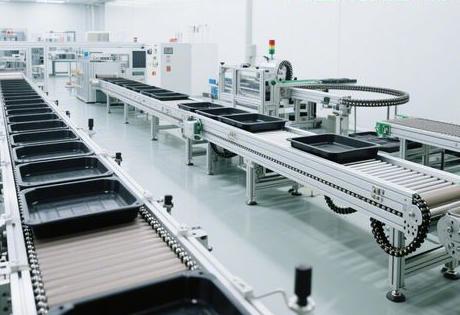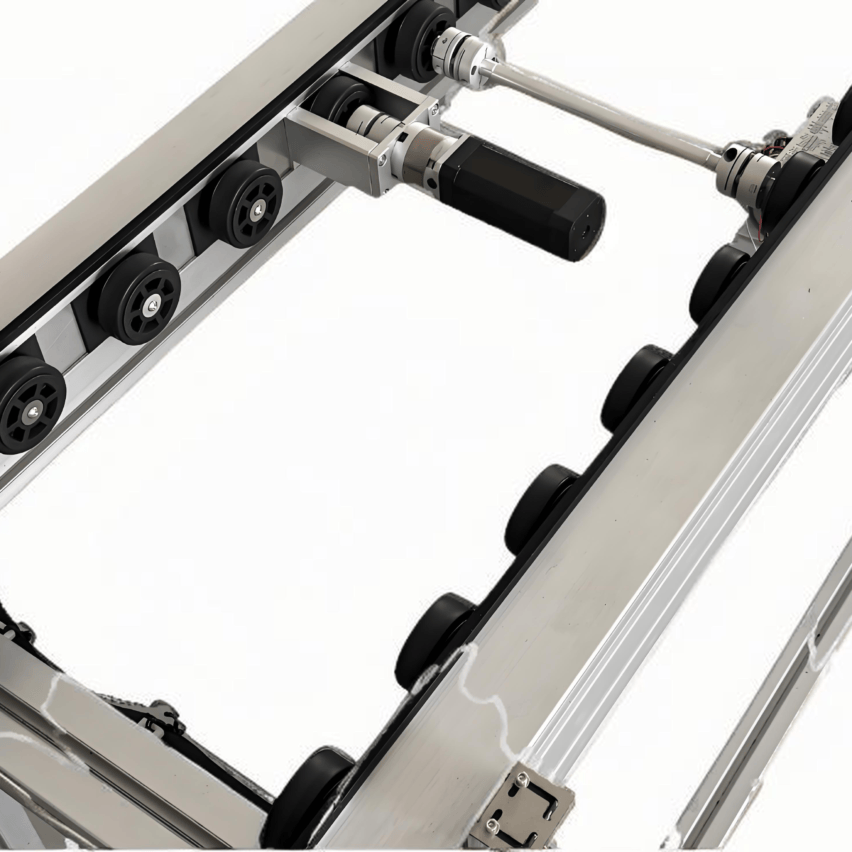I. Principle of growth rate: the game of mechanical structure and physical limits
The core mystery of the left-right circular multiplier chain is that theDesign of diameter difference between roller (diameter D) and roller (diameter d). According to the kinematic equationV_workpiece = V_chain × (1 + D/d)The work plate can be used to obtain a 2.5-3 times increase of the chain speed. However, this theoretical value is often discounted by friction losses:

- Material friction: Sliding friction between the engineering plastic rollers and the aluminium guide rails results in a loss of 8%-12% actual speed increase;
- heavy-lift constraints: Workpieces over 400kg will squeeze the rollers and deform them, and the growth rate ratio is reduced to 2.2 times;
- temperature effect: High temperature lubricant is required when it exceeds 60°C, otherwise the steel chain wear increases 30%.
A car factory measured found: when D / d = 2.5 when the theoretical growth rate should be 3.5 times, but because of the hydraulic fluid viscous effect, the actual only 2.8 times - this reveals a neglected truth.The mechanical efficiency of a multiplier chain is essentially the art of balancing material mechanics and fluid dynamics..
II. Closed-loop structural innovation: from single-layer conveying to three-dimensional circulation
The left-right cycle design is revolutionary in thatClosed reflux system for tooling boardsThe newest and most advanced technology in the world, the newest and most advanced technology in the world, the newest and most advanced technology in the world:
plaintextmake a copy of■ Upper conveyor line: carrying workpieces for positioning and assembly, speed adjustable (5-15m/min) ■ Lower level return channel: empty workpiece plates are automatically returned to the starting point by jacking up the transporter ■ Vertical articulation module: hydraulic lift to achieve ±0.5mm precision across the layer transferActual benefitsDongguan electronics factory adopts this structure, the turnover efficiency of the workpiece board is improved by 40%, and the utilisation rate of the workshop space is improved by 38%.
Key Component Innovation
- Extruded aluminium alloy profile guides: Surface anodising treatment, abrasion resistance is 3 times higher than ordinary steel;
- Dual Mode Blocker: Pneumatic locking accuracy ±2.5mm, up to ±0.1mm with the addition of a fine positioning module;
- Accumulation function design: When a single workpiece plate stalls, the other plates continue to be conveyed without interruption.
III. The Flexibility Revolution in Industry Adaptation
Automotive assembly: the symbiosis of heavy loads and precision
Tesla's Shanghai factory solution:
- Three-row chain structure: Single line load capacity up to 4 tonnes to meet battery pack conveying requirements;
- Magnetically encoded tooling boards: Storage of 200 sets of parameters, RFID-triggered switching of assembly programmes;
- Distributed hydraulic buffers: The rebound of the workpiece is controlled within 0.1mm.
3C Electronics: Micron anti-static battlefield
- Nano-ceramic coated guides: Surface resistance stabilised at 10⁶Ω and ESD risk reduced by 90%;
- Peristaltic Conveying: 0.1m/min low speed matching bonder precision, throw rate to zero.
Medical aseptic environment: zero contamination delivery
- 316L stainless steel rail: Passed GMP 100,000 cleanliness certification;
- Plasma self-cleaning technology: Reduced bacterial adhesion rate of 90% and filling accuracy of 0.05ml.
IV. Three levels of evolution of intelligent control systems
1.0 Base control layer
PLC (Mitsubishi/Siemens) implementation:
- Variable frequency speed regulation (0-15m/min stepless variable speed)
- Blocker linkage response time ≤ 0.3 seconds
2.0 Data Sensing Layer
- RFID traceability system: Generates 2GB of operational data per hour, and reduces the mixed-line traceability timeframe to 20 seconds;
- Laser Displacement Sensor Array: Real-time monitoring of chain speed difference, accuracy ±0.03mm.
3.0 Decision Optimisation Layer
Digital twin implementation:
plaintextmake a copy ofPhysical Entity → MEMS sensor to collect vibration/temperature data Virtual model → Ansys simulation of chain wear (error <3%) AI decision-making → Dynamically adjusting damping parameters (fault prediction rate 92%)A PV plant saves $2.7 million in annual maintenance costs after application.
V. The dialectic of cost-effectiveness
Initial investment vs. hidden benefits
| Configuration programme | Initial cost | Monthly maintenance fee | payback period |
|---|---|---|---|
| Basic version (carbon steel + PLC) | ¥800/m | ¥1200/100 metres | 18 months |
| Smart version (+RFID) | +40% | Drop 70% | 14 months |
| Clean version (stainless steel) | +80% | ¥2800/100 metres | 22 months |
Data derived from the Head Equipment Vendor 2025 Real-World Report
Top 3 Undervalued Gains
- spatial valueDouble-layer cycle design shortens the production line by 12%, with an annual value-added of ¥8,500 per square metre of plant;
- Energy Recovery: Regenerative braking device intercepts 60% impact kinetic energy, saving 240,000 kWh of electricity per year;
- fail-safe: AI Early Warning Reduces 70% Unplanned Downtime, Avoids Over $500K in Annual Losses.
Ask Yourself: The Three Laws of Multiplier Chains
Q1: How to solve the problem of chain offset for extra-long line bodies (>30m)?
-rigid-flexible coupling designis the key:
①Guideway Reinforcement: Alternative splicing of whole sections of aluminium alloy profiles (single up to 12 m long);
②Intelligent deskew: Laser sensor + electronically controlled tensioning wheel to adjust the chain tension in real time;
(iii)Thermal Compensation Tank: Reserve 0.5mm/m expansion joints in the guideway to cope with temperature deformation.
Q2:How to upgrade the intelligent multiplier chain of the old production line at low cost?
three-stage penetration strategyMore economical:
- Perceptual layer retrofitting: RFID read-write (¥ 3000 / Taiwan) + work board labelling (¥ 20 / piece)
- Control Layer Iteration: Edge computing module parsing data (replaces 30%PLC function)
- Energy layer optimisation: Regenerative braking device to recover steering kinetic energy
Q3: Is the aseptic workshop compatible with heavy-duty conveying needs?
Material Compounding ProgrammeBreaking:
- Carbon Fibre Reinforced Plate: Stiffness ↑40% and surface can be plated with antimicrobial film;
- Ceramic-based rollers: Pressure-resistant 800kg and Ra≤0.2μm bacteriostatic surface;
- Fully sealed hydraulic cylinder: zero internal oil leakage, ISO 14644 certified.
I realised when a car company pressed the chain breakage rate down to 0.3% with a 12m whole section of aluminium profile rail.The ultimate value of the left-right circular multiplier chain is not only material handling, but also reconfiguring plant efficiency with spatial topology... IIT 2025 data shows that plants with this system have a capacity density increase of 281 TP3T, but with only 1/6th of the inputs of a robotic production line - revealing a counterintuitive logic.The winners and losers of manufacturing upgrades are often hidden in the millimetre-scale evolution of basic conveyor lines.
In the next three years, with the use of Shape Memory Alloy (SMA) in the tensioning mechanism, perhaps every speed multiplier chain will evolve into a "breathing organic life form". When the German Bosch laboratory uses AI to predict the micro-strain of the chain, the leverage point of China's smart manufacturing may be.Create ¥12,000 more production value per square metre per year.-After all.The real battlefield of the factory is in the 0.01 second energy game when the tooling plate hits the rail..













